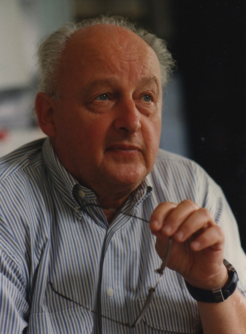Joachim Trümper receives Cothenius medal

Internationally, Joachim Trümper is regarded as one of the pioneers of X-ray astronomy. In 1971, he started with the development of detectors to observe cosmic X-ray sources from stratospheric balloons. In 1976, he and his group managed to measure the extraordinarily strong magnetic field of a neutron star. Further advances in detector development and their placement on the Soviet space station Mir led to the discovery of X-ray radiation from the Supernova 1987A.
Trümper was the initiator and scientific director of the satellite mission ROSAT, which carried out the first complete sky survey with an imaging X-ray telescope in 1990/91. ROSAT was able to boost the number of known X-ray sources from about 5000 to over 200,000. Thousands of scientific publications refer to data obtained with ROSAT. He and his group have been and continue to be actively involved in the X-ray satellites Chandra by NASA and XMM-Newton by ESA, which were launched in 1999 and are still operating.
Joachim Trümper studied physics at the Universities of Halle (Saale), Hamburg and Kiel from 1952 to 1959. In 1959 he received his PhD from the University of Kiel, where he qualified as professor in 1966. From 1971 to 1975 he held the Chair of Astronomy and was Director of the Astronomical Institute of Tübingen University. From 1975 until his retirement in 2001 he was director at the Max Planck Institute for Extraterrestrial Physics (MPE) as well as honorary professor at the Ludwig Maximilian University Munich. At MPE he is still actively engaged in research with a focus on neutron stars and other final stages of stellar evolution.

For his contributions in the field of astrophysics and astronomy, Trümper has been honoured many times. In addition to other awards, he received the Order of Merit of the Federal Republic of Germany, the Max Planck Research Prize for International Cooperation, the Bavarian Order of Merit, the Stern Gerlach Medal of the German Physical Society, the Karl Schwarzschild Medal of the German Astronomical Society, the Tycho Brahe Prize of the European Astronomical Society, and the X-ray Medal of the city of Würzburg, where Wilhelm Conrad Röntgen originally discovered X-rays. Since 1988 he is a member of the Leopoldina.
The Cothenius Medal is based on a foundation by the Leopoldina-member and personal physician of the Prussian king Friedrich II, Christian Andreas von Cothenius (1708-1789). For the first time it was awarded in 1792. Initially, the award winners were selected for addressing medical research questions. Since 1954, the Leopoldina awards the Cothenius medals for outstanding scientific work. As a rule, members of the Academy receive the award. Among the laureates are the physician and zoologist Ernst Haeckel (1864) and Konrad Zuse (1985), the developer of the first computer.













